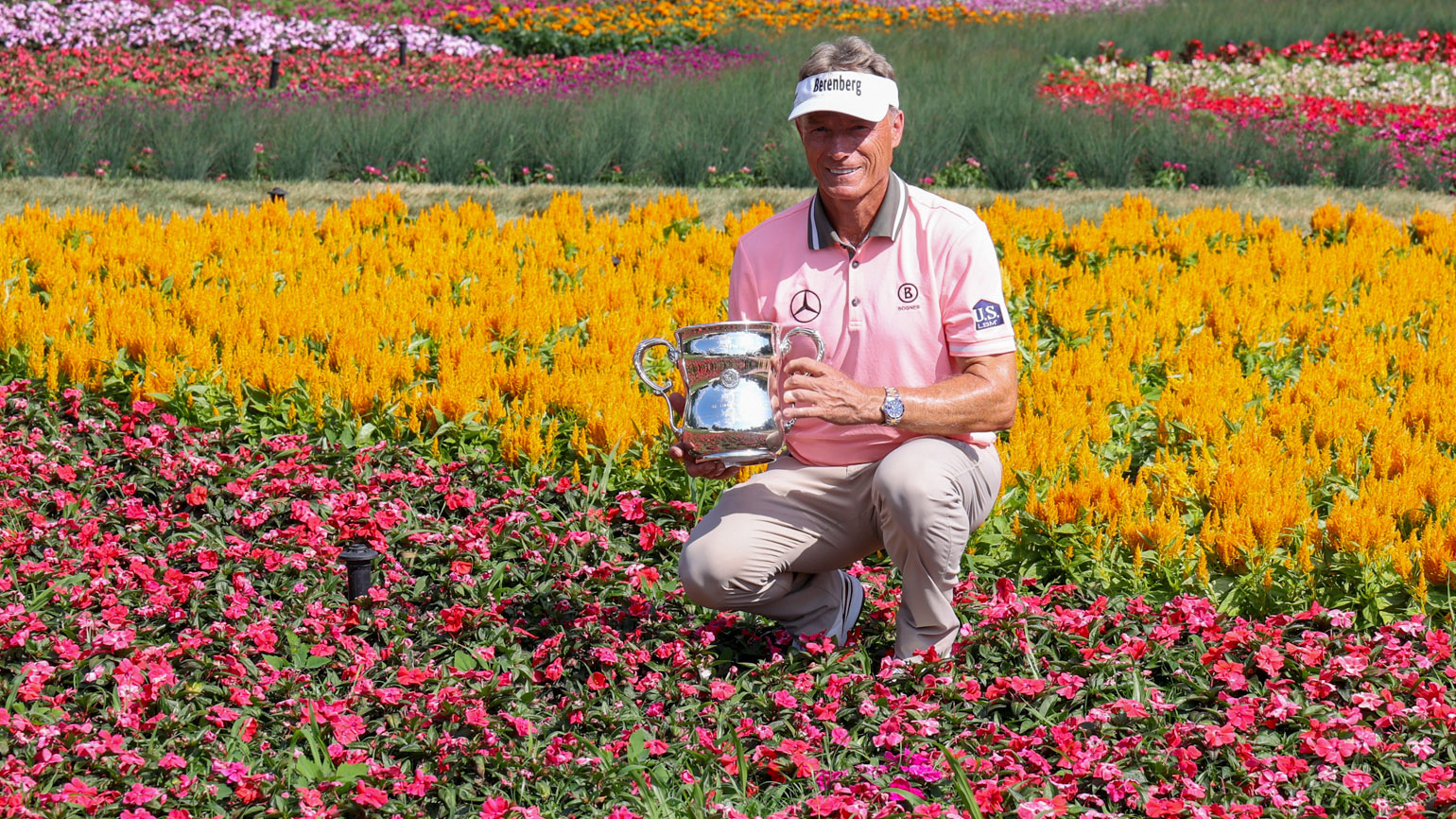2024 U.S. Senior Open Latest Chapter in Newport CC’s Historic Legacy to Game
From the iconic Beaux Arts-style clubhouse designed by Whitney Warren, to being one of the five founding clubs of the United States Golf Association and hosting the inaugural U.S. Amateur and U.S. Open in 1895, Newport (R.I.) Country Club oozes with history.
The next chapter in the club’s 129 years of existence comes this week when the 44th U.S. Senior Open Championship is conducted on the links-style venue designed by legendary architect A.W. Tillinghast and later restored by Ron Forse. Originally planned for 2020, the event was rescheduled due to COVID-19 postponing all but four of the USGA’s championships in the calendar year.
This won’t be the first time the 50-and-over set will test their game at Newport. From 1982-1985, Golf Digest sponsored a Senior Tour (now PGA Tour Champions) event (Merrill Lynch/Golf Digest Commemorative Pro-Am) that attracted all the stars from that era. The winners included U.S. Senior Open champions Billy Casper, Miller Barber and Roberto De Vicenzo, along with Lee Elder.
“This is going to be fun,” said longtime Newport C.C. president Barclay Douglas Jr. of the upcoming U.S. Senior Open, the fifth USGA championship to be held at the club. “Somebody ran into [two-time U.S. Open champion] Lee Janzen at Notre Dame (2019 U.S. Senior Open) and he said, ‘Oh, it’s great going back to that [club]. [Former PGA Tour winner-turned NBC golf analyst] Brad Faxon is a member. We’re hoping to have [Rhode Island natives] Brett Quigley and Billy Andrade. Fran Quinn is from Massachusetts.
“I’m so happy Bernard Langer won last year [at SentryWorld]. He’s a good man. He should be writing a book on how he is in such good shape [at age 66]. Everyone who is collecting Social Security would buy it.”
Douglas’ passion for the game began basically at birth. His grandfather, J. Gordon Douglas, was a founding member of Seminole Golf Club in Florida, and a great uncle, deLancy Koutz, was president of four-time U.S. Open venue and fellow founding USGA club Shinnecock Hills, located in Southampton, N.Y., in 1920.
A year before he ascended to the presidency of Newport’s board, then-vice president Barclay Douglas wrote a letter to P.J. Boatwright Jr., the USGA’s former executive director of Rules and competitions, about bringing the 1995 U.S. Amateur to Newport. The club had not hosted any USGA championships since 1895. Theodore Havemeyer, the first USGA president who helped found Newport C.C., was a key figure in bringing the inaugural U.S. Amateur and U.S. Open to Rhode Island, and the Havemeyer Trophy is annually handed out to the U.S. Amateur champion.
Havemeyer, a wealthy businessman whose family owned the American Sugar Company, first discovered golf on a trip to Pau, France, in 1889, and he brought back his passion for the game to Newport. He convinced several friends, including John Jacob Astor IV, Perry Belmont and Cornelius Vanderbilt II, to purchase 140 acres of farmland in an effort to lay out a golf course. Willie Davis designed the first nine holes and later added nine more after Havemeyer unexpectedly died in 1897. Tillinghast was later hired to design what is the current routing in 1923.
But the club was conspicuously absent from the competitions calendar ever since Charles Blair Macdonald and English-born Newport C.C. professional Horace Rawlins won those events in the nascent days of competitive golf in America. Boatwright and David B. Fay, then the USGA’s assistant executive director (he became executive director in 1989), were attending the 1987 U.S. Women’s Amateur at Rhode Island Country Club, in Barrington, when they made a side visit to Newport. While chatting with Fay, he casually asked him what Boatwright thought of the course.
“He loves it,” Fay told Douglas.
The Centennial U.S. Amateur was awarded to Newport and Tiger Woods wound up capturing the second of three consecutive Havemeyer Trophies with a 2-up win over future U.S. Senior Amateur champion George “Buddy” Marucci Jr. It was the Southern Californian’s fifth USGA title in as many years (Woods won the U.S. Junior Amateur from 1991-93).
While Woods won’t yet be old enough to play in the 2024 Senior Open (he doesn’t turn 50 until December 2025), several players from that championship are eligible and five qualified, including Woods’ ex-Stanford teammate/NBC golf analyst Notah Begay III, former U.S. Ryder Cup player Chris Riley and 1994 U.S. Amateur runner-up Trip Kuehne (lost to Woods at TPC Sawgrass).
The success of the 1995 U.S. Amateur led Douglas and Newport C.C. to pursue the 2006 U.S. Women’s Open, which was won by another World Golf Hall of Fame inductee, Annika Sorenstam. The Swede’s third title came in an 18-hole playoff over Pat Hurst in a week plagued by crazy weather. Nearly 3 inches of rain fell in the days leading up to the championship and the first round was postponed due to heavy fog, forcing the competitors to play 36 holes on Sunday.
Teenager Michelle Wie, who had turned professional the previous fall, was in the mix, but shot a final-round 73 to finish two strokes out of the playoff. She tied for third with 1998 champion and World Golf Hall of Famer Se Ri Pak and Stacy Prammanasudh, with two-time champion/Hall of Famer Juli Inkster three strokes back. Amateur stalwarts Amanda Blumenherst and Jane Park tied for 10th. Park won the U.S. Women’s Amateur in 2004 and Blumenherst would hoist the Robert Cox Trophy two years later.
“That was the championship that couldn’t start and couldn’t end,” Douglas said at the time because of the weather issues. “Going into the week, the golf course was perfect. It was starting to speed up and then the skies opened. We had to bring in the [Newport] Fire Department to put hoses across Ocean Drive [to pump out the water]. It was a very successful week.”
Fast forward to 2017 and Douglas and the club decided the time was right to bring another USGA championship to Newport. The U.S. Senior Open would make Newport one of six clubs to have hosted the U.S. Open, U.S. Women’s Open, U.S. Senior Open and U.S. Amateur, joining Winged Foot, Pinehurst, Cherry Hills, Oakmont and Hazeltine National.
“We thought the Senior Open would be the trifecta of all the Opens,” said Douglas. “It’s nice to say this little sleepy club in Newport, R.I., that people [often] look over. The golf course is fitting for everybody who wants to play it, whether you are a 36-handicap or a plus-4.
“It starts with the terrain. Tillinghast did a great job with it. A lot of people appreciate the design. The natural winds make it challenging. And ever since the mid-[19]80s, we’ve started to lengthen the golf course.”
Forse was brought in to help with that restoration process, but the changes didn’t occur overnight. The membership, Douglas said, wanted to start small and see how those updates would affect the playing characteristics of the layout. Over the last two decades, more than 500 yards has been added to get the course up to modern standards. Newport can now play in excess of 7,000 yards from the championship tees (it will measure 7,070 yards, par 70 for the U.S. Senior Open). The club also installed 5 miles of ADS (Advanced Drainage System) pipe to improve drainage.
Charles Coen, who as the assistant superintendent during the 2006 U.S. Women’s Open played a major role in getting the course in acceptable playing conditions, also undertook a major green restoration project when the club decided to hire him as the superintendent in 2015. Faced with a thatch issue, Coen and his team used bristle brushes to remove the organic debris.
“He did a great job of making the greens superb,” said Douglas, who is the longest-tenured president in Newport’s illustrious history. “One of the things my father always told me is to put things in better conditions than you found them.”
Barring any unforeseen weather issues, competitors in the 2024 U.S. Senior Open will find a course that rewards precision over length. Douglas said the player who succeeds at Newport will be accurate off the tee and avoid the rough. The nines have also been reversed for logistical purposes. The area around the club’s ninth green (No. 18 for the championship) has more room for hospitality and grandstands. A large area near that green, which was an old practice area, can also accommodate the Merchandise Pavilion and other facilities.
The course also features back-to-back par-3 holes (Nos. 4 and 5 for the championship), a characteristic only found at a handful of layouts (Cypress Point, Quaker Ridge and Pacific Dunes are three known venues). Changing the nines also allows the players to finish with two par-4s (Nos. 15 and 18), a par 3 (No. 17) and a par 5 (No. 16) instead of four consecutive par 4s.
Perhaps it is also fitting that the 2024 U.S. Senior Open at Newport will be the 1,001st championship in USGA history. The first 1,000 began at this summer hideaway for wealthy businessmen and now the next 1,000 kicks off there.
“I get goosebumps just thinking about it,” said Quigley, who tied for fourth in last year’s Senior Open and has won multiple PGA Tour Champions events. “The clubhouse, the property, I know the history behind it. And the golf course, it’s just a beautiful walk.”
David Shefter is a senior staff writer for the USGA. Email him at dshefter@usga.org
















